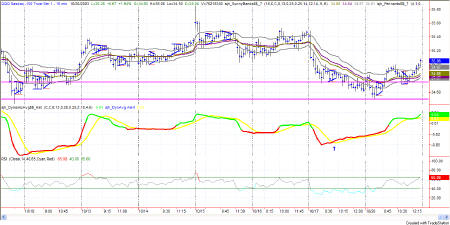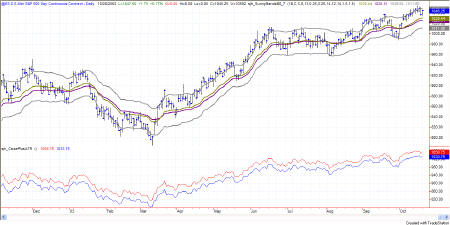
The Sunny Side of the Street
TECHNICAL ANALYSIS EDUCATION: EXPLAINED AND DECIPHERED FOR NEW AND
VETERAN TECHNICAL ANALYSTS ALIKE.
MONDAY EVENING -
Oct 20, 2003
Archives of Past
Commentaries . How Did We Do?
Weekend Stock Picks --
CLICK HERE
| Anyone interested in posting comments or questions to the bulletin board may click here. Sunny personally answers each question or comment posted. | ||
|
|
|
$56,893 in Stock Picks to date! Click Here to view.

Figure 1a: 01 Minute Dow
Yesterday's Shooting Star pattern on the daily chart turned out indeed to be a reversal pattern for today. Yesterday was down, today was up (ish).
You could have approached today a couple of different ways from the technician's viewpoint. Looking at breakouts of pennants, or areas of congestion, you could take Figure 1b and go long from the first breakout of the pennant line at 34.75, and stay long for the remainder of the day. The second pennant formation took the stop up a notch, so that it didn't get broken on the dip, and there was no reason to get short, or get out either one. That approach would have netted a long play of 31 cents (at 5000 shares = $1,550).
Another way to observe today would have been from the Sunny_Bands aspect. From this technical approach we would have noticed the bullish divergence on the RSI, which would be encouraging, and would have gotten us long when price crossed the midline of the Sunny_Band at 9:00amPT at 34.79. We would have exited that trade at 10:15amPT on the close at 34.90, as price closed back below the upper Sunny_Band. At this juncture we would be waiting and watching for price to close back above the upper band, and would have gone long at 12:45pmPT on the close of 34.95 and held long until the end of the day at the close of 35.06. That approach would have netted (again on 5000 shares) 34.90-34.79=11cents + another 11cents on the second leg for a total of 22cents, or $1,100 for the day.
Another approach on today's information could have been to trade breakouts above signal closes on the SDMA_Histogram. That approach would have gotten us long on a close above 34.88, which would have happened at 9:45am and held until the close at 35.06, yielding at total for the day of 18cents, or $900.
Looks like the best approach would have been to trade the breakouts of the pennants, at least for today.
What I like to keep in mind when trading is that a journey of 1000 miles starts with one step. A million dollars a year is made up of lots and lots of trades, not just one. And, $1500 per day adds up to $390,000 per year. Not bad!
In fact, any of today's approaches would have stead us well in the long-term.
While the QQQ basis the daily chart made it out and over the top Sunny_Band today (Figure 1d), the EMini did not yet do so. Figure 1c.
I like it best when the ES confirms the QQQ and vice versa, but that hasn't happened as of today. Nevertheless, I am still expecting a slow, steady growth in the market while climbing a wall of worry as we continue to build a stronger economy.
Attractor: a level to which prices seem to be drawn, like a magnet. Usually these are lines of support or resistance from previous highs and lows, but can also be an important level on an indicator, or the edge of a Sunny_Band.
PHW: Potential Hourly Wage. A term coined by Sunny to examine whether trading for a living is really worth it when compared to the minimum wage standard. Before considering a trading system to be a success, it should pass the PHW test.
RSI: Relative Strength Index (TradeStation function)
SDMA: Sunny's Dynamic Moving Average (proprietary)
Shooting Star: A candlestick pattern discussed further under Reference, Candlesticks.
SDMA_Hst: Sunny's Dynamic Moving Average presented in a histogram format where the line representing the difference between the two SDMA lines turns from red to green when the two SDMA lines cross each other (the difference is zero). The yellow line is an average of the histogram line.
Sunny_Band: Sunny's Dynamic Moving Average plus 1.5 ATR and minus 1.5 ATR, creating a band on either side of the SDMA.
Vehicles: Trading symbols. IBM is an equity vehicle; SPU03 is the SP futures contract that expires in Sept of 2003; @ES.D is the EMini; mutual funds are vehicles; gold is a trading vehicle; etc.
This commentary is meant only for EDUCATIONAL PURPOSES. It is to help you see how a Technical Analyst reads the signs in the markets.
Stay sharp and on your toes. Moves can reverse on a dime, anytime. Let the market speak to you. If the market is going down, by golly ignore my commentary from the night before and know that the market is going down.
RULES OF THUMB:
0. I keep the chart in Figure 1a on each day's commentary simply to illustrate how much in tandem the 4 indexes I watch actually are. For this reason, I don't always comment on every index. Analysis of one speaks highly for the same analysis for each of the other indexes.
1. When price is pushing the upper Sunny_Bands upward and then eases off and moves back toward the midline, it's time to take profits. If it starts moving up and pushing on the Sunny_Bands again, it's time to get back in. Likewise, if the market is pushing down on the lower Sunny_Band and eases off to move back to the midline, it's time to take profits from the short play.
2. Divergence of the RSI and price is another good time to take profits and wait for a breakout of price before taking a position.
3. When the exchange puts in curbs or trading halts on a large move down, it usually (not always) stops the downward motion. After the market reopens is a good time to take profits from your short position.
4. The market can't go nowhere forever. Eventually, who knows how long it will be, there will have to be a breakout-- one direction or the other.
5. This commentary is for educational purposes only, and is meant only to teach readers about my indicators, other technical indicators, and how I read them.
==<:>==
While it may be true that a picture is worth a thousand words, it is definitely not true that a picture deserves a thousand words.


